infra CONVERT
blue DAT • infra DAT
mdm TOOL
infra CONVERT
blue DAT • infra DAT
mdm TOOL
This is an old revision of the document!
User manual infra CONVERT > More
![]()
Quick start
With infra CONVERT, you can quickly and easily create high-quality test plans based on technical drawings. All help topics for the user are prepared in the user manual.
infra CONVERT can be flexibly adapted to the work processes and connected systems in the company. The administrator's manual covers in-depth topics for preparing the program for use.
The following describes a common way to configure infra CONVERT and deploy the defaults across the enterprise.
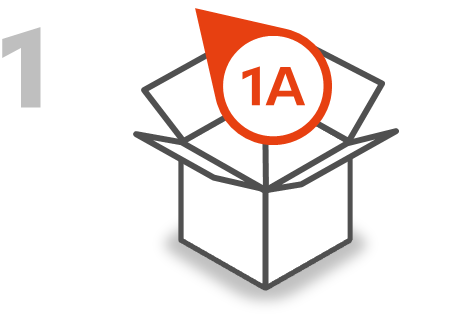
Programm installieren
Installieren Sie infra CONVERT auf den vorgesehenen Arbeitsplatz-PCs (Clients).
Siehe Installation > Systemvoraussetzungen
Siehe Installation > Installation

Lizenz einrichten
Installieren Sie den Lizenzservice, ein Dienstprogramm, auf dem Lizenzserver. Starten Sie infra CONVERT auf einem beliebigen Client im Administratormodus und stellen eine Verbindung zum Lizenzserver her (Server auswählen und den Namen des Hosts eingeben). Senden Sie den angezeigten Registrierungsschlüssel an Ihren Anbieter. Sie erhalten daraufhin eine Lizenzdatei, die Sie auf dem Client in infra CONVERT laden. Die Lizenz wird an den Lizenzserver gesendet und dort gespeichert.
Siehe Einstellungen > Einstellungen > Administration > Start im Administratormodus
Siehe Installation > Serverlizenzierung
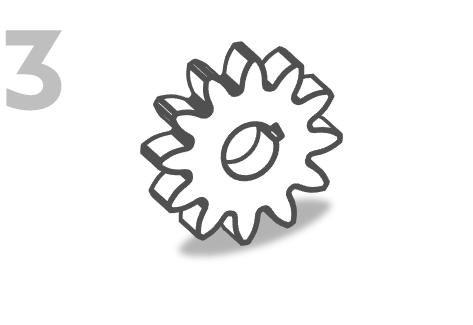
Programm konfigurieren
Legen Sie (weiterhin im Administratormodus) das Verhalten von infra CONVERT in den Einstellungen fest (Bearbeiten > Einstellungen), zum Beispiel den Standard-Projektordner, Details der Merkmalerkennung, die Art der Stempelnummernvergabe und das Verzeichnis für Excel-Prüfberichtsvorlagen.
Siehe Einstellungen > Einstellungen
Erstellen Sie ein Projekt und legen Sie in den Projekteinstellungen (Bearbeiten > Projekteinstellungen) die üblicherweise verwendeten Allgemeintoleranzen fest. Setzen Sie die Definitionen anschließend als Standard (Speichern … > Als Standard setzen).
Siehe Einstellungen > Projekteinstellungen > Toleranztabellen
Siehe Einstellungen > Projekteinstellungen > Toleranztabellen > Speichern/Exportieren
Exportieren Sie die aktuell gesetzten Einstellungen (Bearbeiten > Einstellungen > Administration) und kopieren die Konfigurationsdatei in das Programmdatenverzeichnis der Arbeitsplatz-PCs (»%ProgramData%\ELIAS GmbH\infra-convert«).
Siehe Administratorhandbuch > Konfiguration und Import > Parameterdatei »Settings«
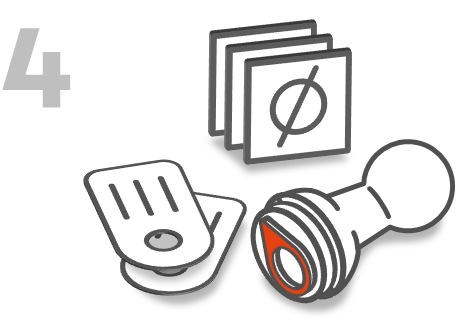
Projektvorlagen erstellen
Benennen Sie Projekt und erste Prüfplanversion. Legen Sie die Definitionen für Kennzeichnungen, Kategorien und Stempelvorlagen fest.* Speichern Sie das Projekt als Vorlage. Verschiedene Prüfplanungsszenarien können so abgebildet werden. Für das Erstellen von Projektvorlagen muss infra CONVERT nicht mehr im Administratormodus ausgeführt werden.
Siehe Funktionen > Projekte > Projekt als Vorlage speichern
* – Klassendefinitionen können mit einem Texteditor in der entsprechenden Konfigurationsdatei angepasst werden. Nach der Anpassung muss ein neues Projekt erstellt werden, um die Definitionen zu laden.
Siehe Administratorhandbuch > Konfiguration und Import > Parameterdatei »CharacteristicClasses«
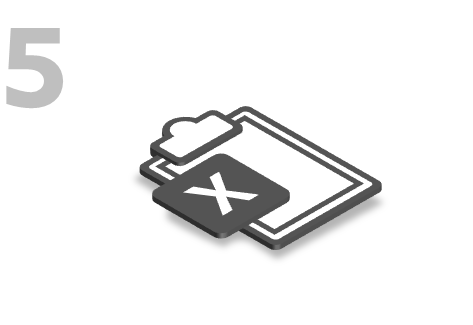
Prüfberichtsvorlagen erstellen
Sie können aus infra CONVERT heraus die Prüfplandaten direkt in einen Excel-Prüfbericht exportieren. Die mitgelieferten Excel-Vorlagen können direkt verwendet oder abgeändert werden. Sie können eigene Vorlagen erstellen oder bereits vorhandene Prüfberichtsvorlagen weiterverwenden.
Siehe Weiteres > Excel-Vorlagen erstellen und anpassen
Es kann nun mit der produktiven Arbeit begonnen werden.
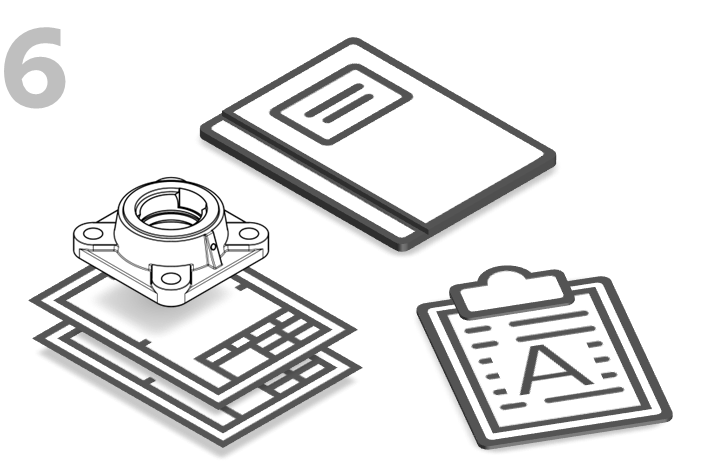
Projekt und Prüfplan erstellen
Erstellen Sie je zu prüfendem Objekt (Bauteil oder Baugruppe mit einer Sachnummer) ein Projekt. Einem Prüfplan können mehrere Zeichnungsblätter zugeordnet werden.
Siehe Von der Zeichnung zum Prüfplan
Siehe Zeichnungsdatenformat
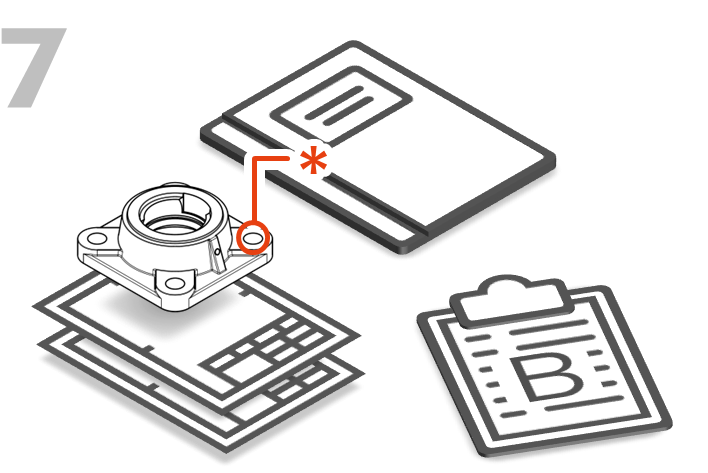
Prüfplan versionieren
Im Falle einer Zeichnungsänderung können Sie mithilfe des Zeichnungsvergleichs schnell und sicher eine neue Prüfplanversion auf Basis der Vorgängerversion erstellen. Prüfplanversionen werden innerhalb eines Projekts verwaltet.
Siehe Zeichnungen vergleichen
Nachfolgend führen wir Sie durch die grundlegenden Schritte, um in infra CONVERT aus einer Zeichnung einen Prüfplan zu erstellen.
Alternativ stehen die kostenfreien Schulungsvideos (YouTube) bereit.
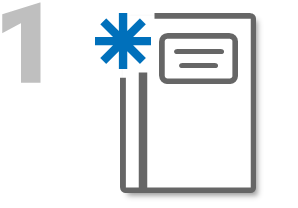
(Vollständige Funktionsbeschreibung: Funktionen > Projekte > Neues Projekt anlegen)
| Step | Action | Result | |
|---|---|---|---|
| 1 | Create project | There are three ways to create a new project: 1a) Create a blank project.¹ 1b) Create a blank project and load drawing sheets directly.¹ 1c) Create a project based on a template.² ¹ – The project configurations (definitions for classes, categories, tags, stamp templates) are loaded from individual configuration files. ² – Configuration files are disregarded, all project configurations are stored in the project template file (*.icpt). Available only in Pro version and from program version 3.2.0. |
|
| 1a | Create blank project | Click New Project ( | The “Project overview” window is displayed next to the drawing area. See User interface > Function window > Project overview Note 1 Only one project can be open and edited at a time. Note 2 The project is not saved yet. |
| 1b | Create project from drawing | 1) Click Create project from drawing ( Note Available from program version 3.0.0. | 1) The file manager of the operating system opens. |
| 2) You can now import one or more drawings. See Functions > Drawings > Import drawing | The “Project overview” window is displayed next to the drawing area. See User interface > Function window > Project overview Note 1 Only one project can be open and edited at a time. Note 2 The project is not saved yet. |
||
| 1c | Create project from template | Select a project template to create a project from it. Project templates provided in the template directory are listed on the Project Templates tab on the start page and under File (menu bar) > New from Template ( Project templates from another directory can be created on the start page via Create project from template ( A project can also be created by opening a project template file (*.icpt) directly from the file system. Note Available only in the Pro version and from program version 3.2.0. | A new project is created based on the project template. |
| 2 | Edit project title | 1) Next to the project title “New project” click the button | 1) The “Edit project” dialog box opens. |
| 2) Enter a unique name in the “Project title” field, under which you will later find the project again. The “Description” field can be used optionally. | 2) The information is entered. | ||
| 3 | Confirm information | Then click OK. | Project title and description have been taken over and are displayed accordingly. |
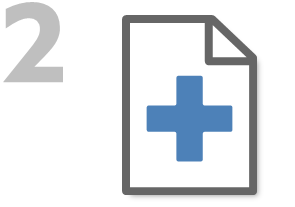
(Vollständige Funktionsbeschreibung: Funktionen > Zeichnungen > Zeichnung importieren)
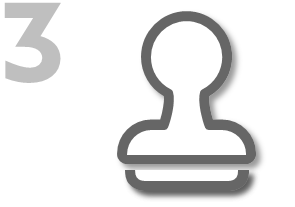
(Vollständige Funktionsbeschreibung: Funktionen > Merkmale > Automatisch stempeln; alternative Funktion: Funktionen > Merkmale > Manuell stempeln)
| Step | Action | Result | |
|---|---|---|---|
| 1 | Open drawing sheet | Open the drawing sheet that you would like to stamp. | The drawing sheet is displayed in the drawing window. |
| 2 | Activate stamp tool | Click on the Stamp tool button ( | If you now move the mouse pointer into the drawing window, it will be displayed as a stamp ( |
| 3 | Check/set start value for the numbering | 1) Set the start value in the Stamp-with dialog or in the Characteristic overview window. You can use the three-dot button in the Stamp number field to set the start value or the next free number via a context menu. | 1) The starting value is fixed. |
| 2) Define further properties in the Stamp with dialog: • Prefix and suffix as a supplement for the stamp text • Category • Tag • Tolerance table and class for generally tolerated dimensions | 2) The properties are fully selected. | ||
| 4 | Stamp | There are three alternative sub-functions available for the actual stamping: 4a) Stamp a characteristic individually. 4b) Automatically recognize and stamp all characteristics in one area. |
|
| 4a | Stamp individual characteristic | Move the mouse pointer (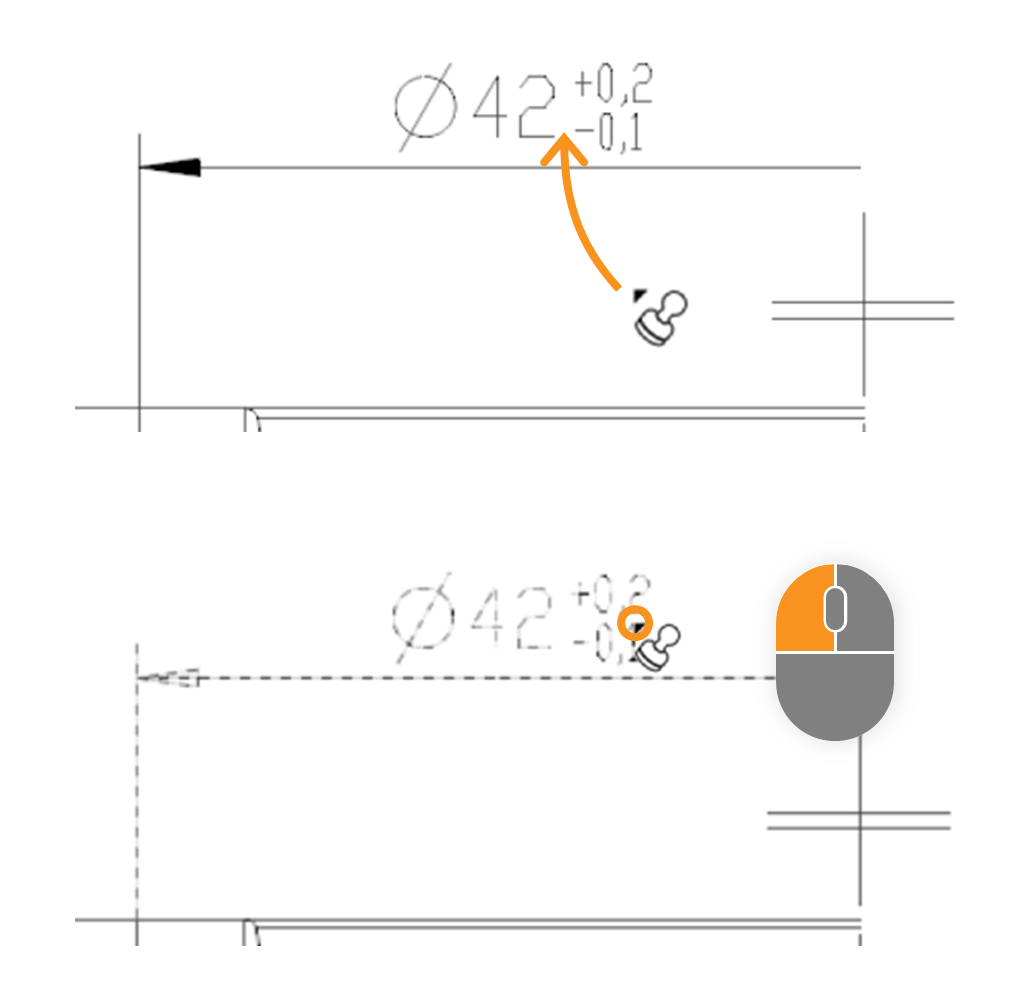 | In the expample the size “□86” is stamped. After stamping, it received a stamp with the number “1” and appears as an entry in the characteristic overview: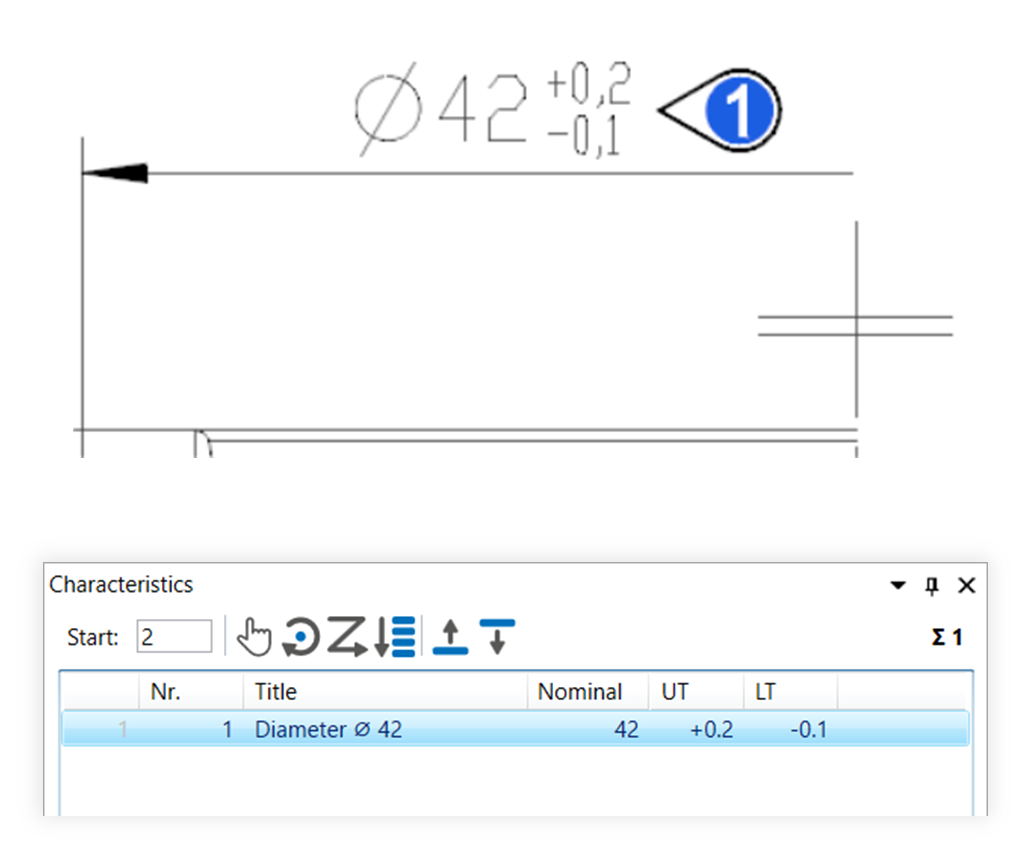 |
| 4b | Stamp area | Move the mouse pointer (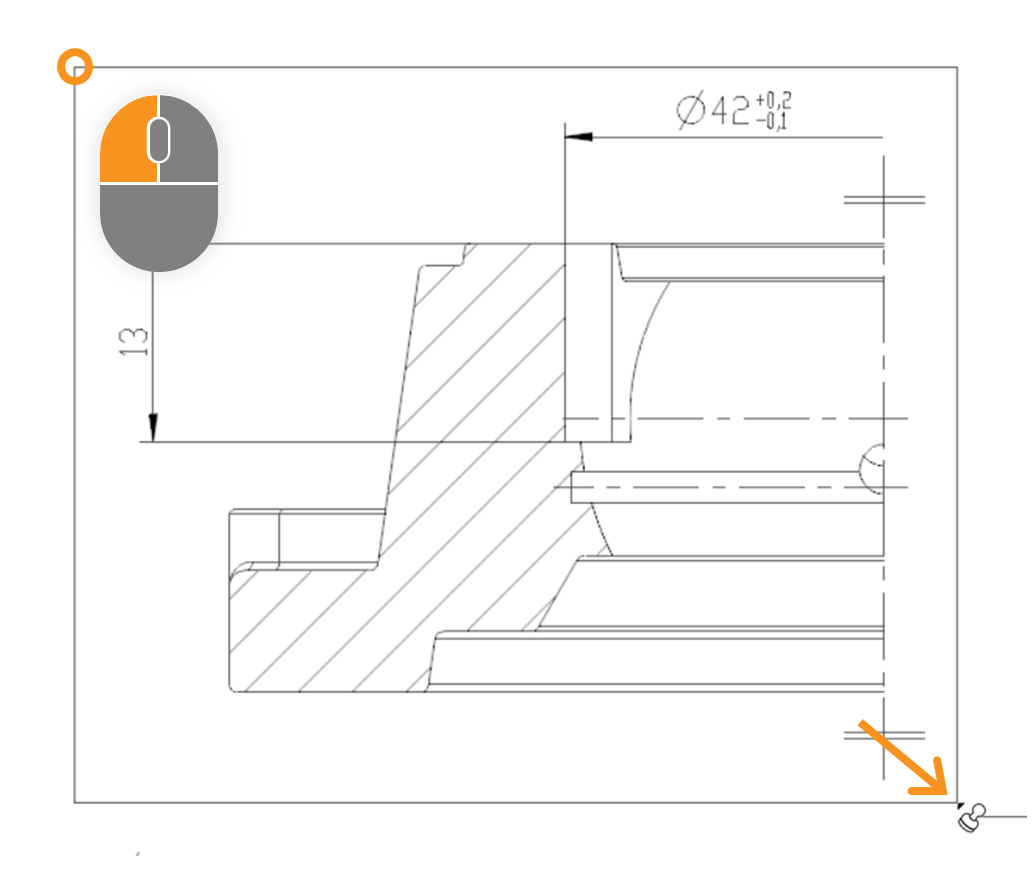 | After stamping, all relevant characteristics of the area received a VDA stamp with numbers from “1” to “7” and appear as an entry in the characteristics overview: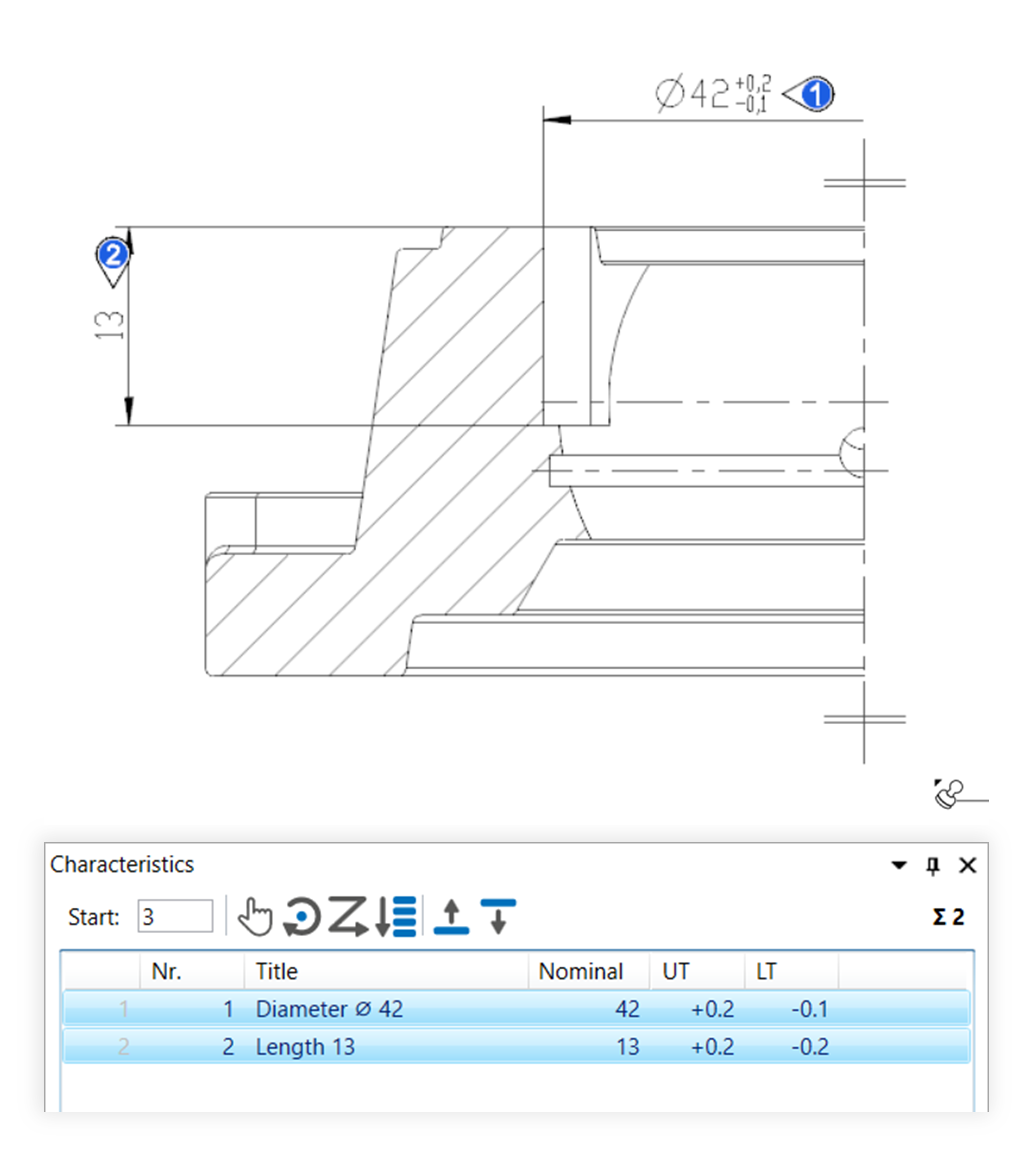 |

(Vollständige Funktionsbeschreibung: Funktionen > Merkmale > Stempel neu positionieren und ausrichten)
| Step | Action | Result | |
|---|---|---|---|
| 1 | Activate Selection tool | Click the Select Tool button ( Note You can also move stamps and targets with other tools. However, we recommend the Selection tool. |
|
| 2 | Move stamp or stamp targets | You can now: 2a) Move stamps 2b) Move stamp targets |
|
| 2a | Move stamps | 1) Click with the left mouse button on the stamp to be moved and keep the button pressed. To move several stamps together, first select them, right-click on one of the stamps and select Move stamp as group from the context menu. Note Move stamp as group is available from program version 4.2.9. | 1) The stamp (or group of stamps) is now coupled with the mouse pointer. 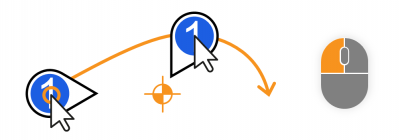 |
| 2) Release the stamp (or group of stamps) at the desired position. | 2) The stamp (or group of stamps) is now positioned and aligned. | ||
Additional function Press the STRG key while moving to snap the stamp to a grid.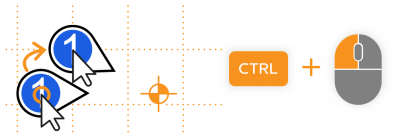 Note Available from program version 4.2.9. |
|||
| 2b | Move stamp targets | 1) Right-click the stamp whose destination you want to move and select Move stamp target ( To move the targets of multiple stamps together, first select the stamps, right-click on one of the stamps and choose Move stamp targets as group from the context menu. Note The context menu entry Move stamp target as well as moving stamp targets as a group is available from program version 4.2.9. | 1) The target point (or group of target points) is now linked to the mouse pointer.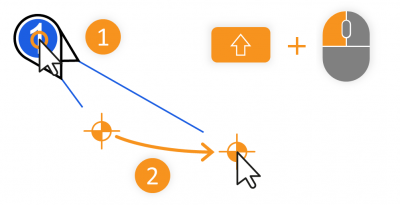 |
| 2) If you have started the function via the context menu, click the left mouse button at the desired position. If you are working with the Shift key, release the mouse button at the desired position. | 2) The target point (or group of target points) is now repositioned. | ||
Additional function Press the STRG key while moving to snap the stamp target to a grid.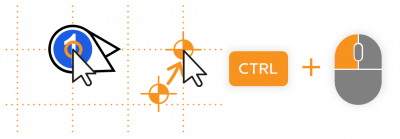 Note Available from program version 4.2.9. |
|||

(Vollständige Funktionsbeschreibung: Funktionen > Merkmale > Nummerierung ändern)
| Step | Action | Result | |
|---|---|---|---|
| 2 | Set start value | Enter the desired number in the field for the start value in the Characteristics list function window, which is to be assigned for the next characteristic to be numbered. | The starting value is predetermined, for example “1”: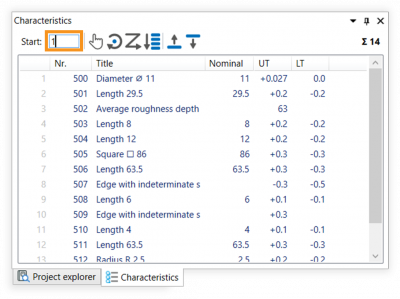 |
| 2 | Numbering | Four alternative functions are available for the numbering: 2a) Manually number 2b) Number clockwise 2c) Number in reading direction 2d) Renumber by list position |
|
| 2a | Manually number | 1) Click on the Manually number button ( | 1) The Manually number mode is now active. |
2) Move the mouse pointer over the drawing surface and click on the stamp of the desired characteristic.: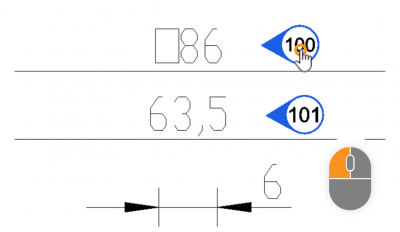 | 2) The characteristic number has been changed: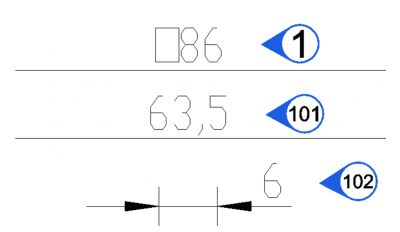 The next free number is now displayed in the field for the start number. Note If a number has already been assigned, the next free number is automatically selected. |
||
| 3) You can now click on additional characteristics or leave the Manually number mode by clicking on the Selection tool button ( | 3) If necessary, additional characteristics are re-numbered. The Manually number mode is now no longer active. | ||
| 2b | Number clockwise | 1) Select the characteristics to be numbered, either by selection in the characteristics list or on the drawing sheet (see also User interface > Operation – Special features when selecting). | 1) The desired characteristics are selected. The drawing view mentioned in step 1 is to be re-numbered consecutively in the example. |
| 2) Click on the Number clockwise button ( | 2) The Stamp clockwise mode is now active. | ||
3) Move the mouse pointer over the drawing surface (the pointer is now displayed as a positioning cursor 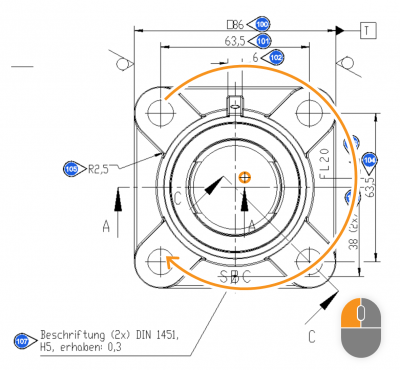 | 3) The characteristic numbers have been re-numbered corresponding to their position relative to the center point: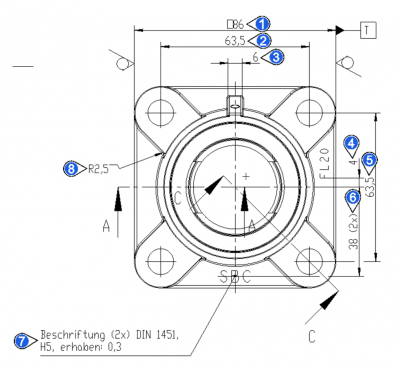 The next free number is displayed in the field for the start number. Note If a number has already been assigned, the next free number is always automatically selected. |
||
| 2c | Number in reading direction | 1) Select the characteristics to be numbered, either by selection in the characteristics list or on the drawing sheet (see also User interface > Operation – Special features when selecting). | 1) The desired characteristics are selected. The drawing view mentioned in step 1 is to be re-numbered consecutively in the example. |
| 2) Click on the Number in reading direction button ( | 2) The characteristics are now numbered in the reading direction (from left to right and top to bottom):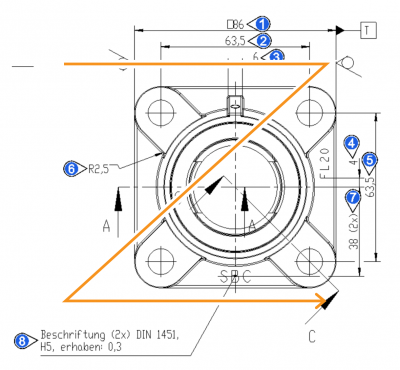 The next free number is displayed in the field for the start number. Note If a number has already been assigned, the next free number is always automatically selected. |
||
| 2d | Renumber by list position | 1) Select the characteristics to be numbered, either by selection in the characteristics list or on the drawing sheet (see also User interface > Operation – Special features when selecting). | 1) The desired characteristics are selected: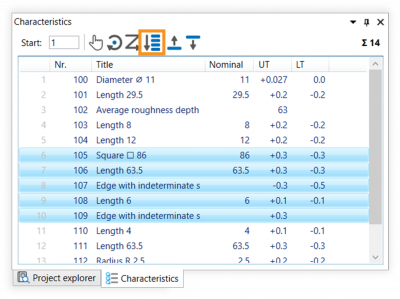 |
| 2) Click on the Renumber by list position button ( | 2) The characteristic numbers have been re-numbered corresponding to their position in the characteristic list: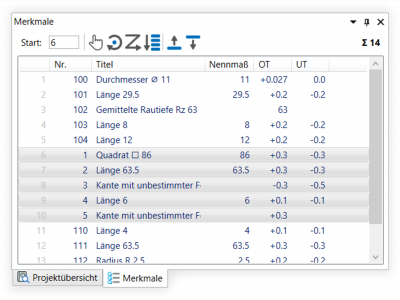 The next free number is displayed in the field for the start number. Note If a number has already been assigned, the next free number is always automatically selected. |
||

(Vollständige Funktionsbeschreibung: Funktionen > Export > Zeichnung exportieren)
| Step | Action | Result | |
|---|---|---|---|
| [1] | [Optional] Prepare view | Instead of exporting all contents, you can also export only a section of the contents of a sheet. You define the view as follows. Open the drawing sheet and fit the desired section into the window. For example, use the view tools Dynamic zoom ( 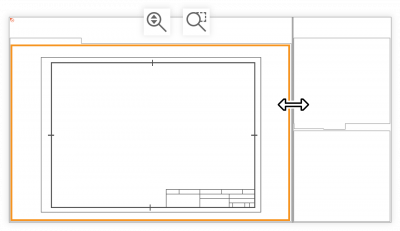 | The desired section is fitted into the drawing window.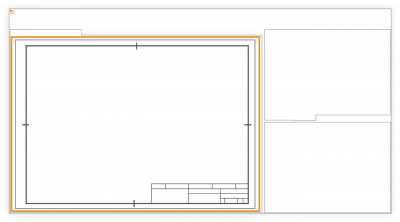 |
| 2 | Select the drawing sheets | In the Project overview window, right-click on the test plan version whose drawing sheets you want to export or on the drawing sheet if you only want to export this one. Select the Export as PDF ( Note Export of several sheets to one file is possible from program version 3.3.4. | The Export document to PDF dialog window opens. |
| 3 | Check export settings | Here you can check the export parameters and settings and make changes if necessary: Content Export the entire drawing sheet or limit the exported section to the current view see Step 1, Prepare view Page format Set the size of the sheet (default size or custom size) Color filter Specify which elements are to be displayed in color, gray or black and white Properties Save metadata as document properties Convert text to geometry Export characters as vectorized geometric elements Open PDF after export Open the exported file with the program set as default after the export is complete. | The export settings are correct. |
| 4 | Export drawing | Click Export at the bottom of the dialog box. In the file manager that opens, specify the location and file name. | The drawing sheet has been exported and saved in the specified location. |
| PNG, TIF, JPG, BMP, GIF | |||
| 1 | Check export settings | Make sure that the export format for drawings is set correctly. Open the Settings menu via Edit (menu bar) > Settings > Export. In the group Drawing graphics you can check the settings and change them if necessary. See also Settings > Preferences > “Drawing graphic format” group group | The settings are as desired. |
| 2 | Select drawing sheets | In the Project overview window, right-click on the test plan version whose drawing sheets you want to export as a graphic. In the context menu, select Export to multiple files > Drawing Graphic. | The Browse Folder dialog box opens. |
| 3 | Export drawing sheets | Select the location in the directory tree and click OK. | The drawing sheets have been exported. |
| SVG | |||
| 1 | Select drawing sheet | In the Project Overview window, right-click on the drawing sheet you want to export. In the context menu, select the function Export as SVG. | The dialog window Export drawing sheet version to SVG opens. |
| 2 | Check export settings | The export parameters and settings can be checked and changes made if necessary in the Export document as SVG dialog window: Layout export settings Export the drawing sheet with or without stamps. Options Export drawing elements in monochrome or in the original colors (Monochrome mode); open the exported file with the program set as default after the export is complete. | |
| 3 | Export drawing sheet | In the directory tree, select the location and click Export. | The drawing sheets have been exported. |

(Vollständige Funktionsbeschreibung: Funktionen > Export > Prüfplan exportieren)
| Step | Action | Result | |
|---|---|---|---|
| 1 | Select test plan | In the Project overview, right-click on the test plan version you with to export and then place the cursor over the list entry Export as in the context menu that opens. | 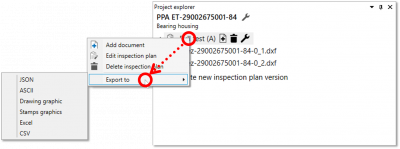 |
| 2 | Export test plan … | The test plan can now be … 2a) …exported in JSON format. 2b) … exported in ASCII transfer format. 2c) … exported in CSV format. 2d) … exported to an Excel file. |
|
| 2a | … in JSON format | In the sub-menu of the context menu, click on Json. | In the file manager window that opens, you can now save the file as usual in a location of your choice |
| 2b | … in ASCII transfer format | 1) In the sub-menu of the context menu, click on ASCII transfer format. | 1) The Export in ASCII transfer format dialogue window will open: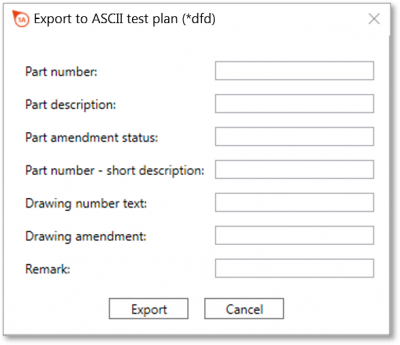 |
| 2) Here, you can enter data for the file header and then click on Export. | 2) In the file manager window that opens, you can now save the file as usual in a location of your choice | ||
| 2c | … in CSV format | In the sub-menu of the context menu, click on CSV. | In the file manager window that opens, you can now save the file as usual in a location of your choice |
| 2d | … to an Excel file | 1) In the sub-menu of the context menu, click on Excel. Note Microsoft Excel must be installed on the computer to execute the export. | 1) The Export to an Excel file dialogue window will open: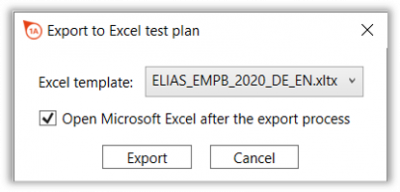 |
| 2) Here, you can now select the Excel template file and check the Open Excel box if you want Microsoft Excel to open once the export is complete. Then, click Export. | 2) In the file manager window that opens, you can now save the file as usual in a location of your choice | ||
Go to previous page
F A Q – Frequently asked questions and answers